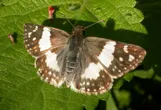Harmful Effects of Millet skipper
A species of Branded swifts, Also known as Pale small-branded swift, White-banded swift
Millet skipper larvae feed on grass species, creating holes and notches in leaves, which impairs photosynthesis and can diminish plant vigor and growth.
What Type of Pest Is Millet skipper?









AI entomologist in your pocket
Scan QR code to download

